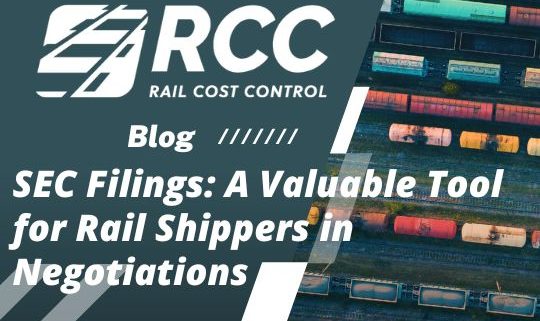Why SEC Filings Are Valuable Tools for Rail Shippers in Negotiations
When negotiating rail freight rates, shippers often feel they’re at a disadvantage due to the complexity and lack of competition in the rail industry.
However, one powerful, yet often overlooked, source of leverage comes from an unlikely place: Securities and Exchange Commission (SEC) filings. These public documents—required by law for publicly traded companies—offer a wealth of financial and operational data that rail shippers can use to their advantage during negotiations.
Transparency into Railroad Financials
SEC filings, such as 10-Ks and 10-Qs, offer detailed insights into a railroad’s revenue, profit margins, and cost structures. Railroads must disclose information on volumes, revenue, pricing trends, operating ratios, freight expenses, and numerous other details that can be used to determine opportunities for negotiating better rates or service commitments.
Specific Examples for Reducing Cost
Once you know how a railroads SEC data has changed over time it opens up new sources of negotiation leverage with railroads. A few examples of how SEC data is used in strategic planning for rail negotiations are:
1. How a railroads’ costs have changed over time.
This can put a lid on your rate increases and may also offer an opportunity for discussions about rate decreases.
2. The level of a railroads’ profit.
You can then decide whether the railroad’s profit from moving your products is greater than your profit from producing products.
3. The overall average percent increase in a railroads rate.
It is always important to Know if your rates are increasing more than the average for your railroad.
4. The change in railroads’ fuel cost
This allows you to check the accuracy of a railroads fuel surcharge program. (Change in fuel cost versus fuel surcharge revenue).
Benchmarking and Competitive Positioning
If a shipper sees that a railroad has had rising profit margins, while service levels have remained static or declined, it may signal that there’s room to push back on rate increases. Similarly, if a railroad is heavily investing in a specific corridor or terminal, it could suggest greater willingness to negotiate to fill capacity in that area.
Shippers can also use SEC data to benchmark rail carriers against one another. This is particularly useful when a shipper is served by more than one Class I railroad or has the option to interchange traffic. Knowing which railroad has the lower operating ratio or which one is investing more aggressively in infrastructure can be a persuasive tool in negotiations. Railroads competing for business respond not only to volume, but to informed shippers who understand their business economics.
In addition, SEC filings sometimes reveal strategic priorities—such as growing intermodal, agricultural, or energy sectors—which can help shippers align their messaging with the railroad’s goals and potentially secure better terms.
Conclusion: Rail Shippers Need the Rail Cost Control (RCC) Program
While SEC filings are a valuable resource, they are just one piece of the puzzle. To fully leverage them in rail negotiations, shippers need context, interpretation, and tools to compare rates and costs across movements. That’s where the Rail Cost Control (RCC) program becomes essential. RCC combines SEC data with proprietary rate benchmarks, the Public Use Waybill Sample, and network modeling tools to give shippers a complete picture of their rail spend and negotiating position. It transforms raw data into actionable insights—empowering shippers to push for fairer rates, defend against unjustified increases, and strategically manage their rail costs.
In today’s complex freight landscape, informed shippers win—and RCC ensures they are informed.



